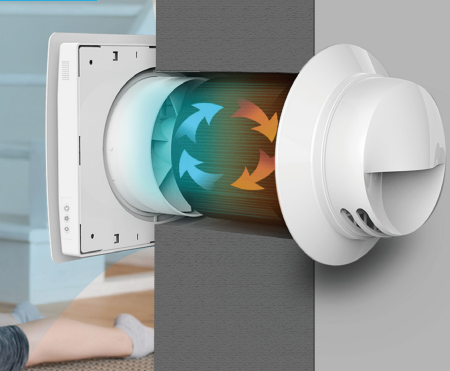Exactly How Heat Recovery Ventilation Enhances Indoor Air Top Quality and Reduces Energy Prices
Heat Recovery Ventilation (HRV) systems play a crucial function in boosting indoor air top quality while concurrently lowering power expenditures. By effectively trading stagnant interior air with fresh outside air, HRVs aid preserve ideal humidity and lower contaminants. In addition, their ability to recoup heat from outbound air minimizes the pressure on heating and cooling systems. As power prices continue to climb, understanding the full possibility of HRV systems becomes progressively vital for homeowners and services alike.
Understanding Heat Recovery Ventilation Systems

Heat recovery ventilation (HRV) systems play a vital duty in improving indoor air high quality, particularly in contemporary, energy-efficient buildings. These systems are created to transfer warm from the outward bound stale air to the inbound fresh air, consequently lessening energy loss while preserving ideal temperature level degrees indoors. HRVs contain a warmth exchanger, fans, and ductwork, assisting in the continuous flow of air. By getting rid of indoor pollutants and introducing fresh air, HRVs aid to balance humidity degrees, stop mold development, and reduce allergens. The effectiveness of HRV systems depends on their capability to recuperate approximately 80% of the warm from the exhausted air, promoting power conservation while ensuring a healthy and balanced indoor environment. Their combination is essential in attaining lasting living practices.
The Relevance of Indoor Air Top Quality
Indoor air quality (IAQ) is an important element influencing the wellness and health of owners in any type of atmosphere. Poor IAQ can cause various health and wellness concerns, consisting of respiratory troubles, allergies, and fatigue. In addition, it can intensify existing problems such as asthma. Factors adding to low IAQ include toxins from indoor resources like cleaning up agents, mold, and inadequate ventilation. Consequently, keeping excellent IAQ is essential for advertising a secure and comfy living or working room. Reliable techniques to improve IAQ entail normal tracking of air quality, correct ventilation systems, and decreasing using hazardous materials indoors. By focusing on IAQ, individuals can ensure a much healthier environment that promotes productivity and total quality of life.
Energy Effectiveness Conveniences of HRV Equipments
Many property owners and building supervisors are progressively identifying the power performance benefits of heat recuperation ventilation (HRV) systems. By moving heat from tired indoor air to inbound fresh air, HRV systems significantly lower the power needed for cooling and heating. This process minimizes reliance on traditional heating and cooling systems, causing lower energy bills. Additionally, HRVs assist wikipedia reference preserve a balanced indoor environment, preventing too much home heating or cooling down demands. The ability to recover approximately 90% of the warmth from outward bound air likewise supports sustainability efforts by reducing total energy consumption. Subsequently, HRV systems add not only to cost savings however likewise to a minimized carbon impact, straightening with the expanding focus on energy-efficient structure practices.
Setup and Maintenance Considerations
The efficient execution of heat healing ventilation (HRV) systems requires careful consideration of installation and upkeep variables to guarantee peak efficiency. Correct positioning of the HRV unit is necessary, as it must be set up in a place that makes the most of air flow while reducing noise disruption. In addition, ductwork should be suitably sized and insulated to protect against energy loss. Regular upkeep, including filter substitute and system cleansing, is vital to secure optimal performance and indoor air top quality. Proprietors should develop a routine maintenance schedule to determine and address possible concerns before they escalate. Partnership with knowledgeable professionals during both installment and maintenance phases can improve the longevity and efficiency of HRV systems, eventually bring about better indoor environments and minimized energy prices.
Real-World Applications and Success Stories
Discovering real-world applications of warm recovery ventilation (HRV) systems reveals their considerable find out this here effect on indoor air top quality and power performance across numerous setups. In residential structures, property owners have actually reported improved air high quality, resulting in fewer allergic reactions and respiratory problems. Schools applying HRV systems have actually noted enhanced pupil focus and reduced absenteeism as a result of better ventilation. Business structures, such as offices and retail areas, have actually experienced reduced energy expenses and raised employee efficiency. As an example, a company workplace in a temperate climate achieved a 30% reduction in power expenses after installing an HRV system. These success tales demonstrate that HRV modern technology not just adds to healthier environments yet likewise offers tangible economic advantages, making it an important financial investment for different fields.
Regularly Asked Concerns
Can HRV Equipments Lower Irritants in Indoor Air?
The efficiency of HRV systems in minimizing indoor irritants mainly depends upon their capability to filter and exchange air. HRV Heat Recovery Ventilation. By constantly changing stagnant air, these systems can significantly lower irritant levels throughout interior environments

Exactly How Does Humidity Affect HRV System Performance?
Moisture considerably influences HRV system efficiency; high degrees can result in condensation, reducing performance, while reduced humidity might improve air exchange. Balancing moisture is vital for excellent operation and preserving indoor air high quality.
Are HRV Solutions Noisy Throughout Procedure?
HRV systems can generate differing sound degrees throughout procedure, depending upon their layout and installment. Some devices run silently, while others might produce obvious noise, particularly at higher air flow settings or when badly maintained.
What Is the Average Lifespan of an HRV System?

Can HRV Solutions Be Utilized in All Environments?
HRV systems can be used in various climates, yet their effectiveness may vary - HRV Heat Recovery Ventilation. In extreme temperature levels, changes or supplemental systems may be necessary to assure optimal efficiency and comfort while preserving indoor air high quality